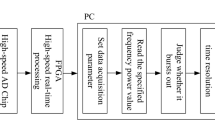Abstract
Investigations related to the impact caused by solar radio burst emissions on space weather forecasting and human activities have been ongoing for a long time. Solar activities based on radio spectra are recorded by using a radio spectrometer from ground Earth. Currently, manual observations are conducted for burst detection using the Compound Astronomical Low-Cost Low-Frequency Instrument for Spectroscopy and Transportable Observatory (CALLISTO) spectrometer that is able to generate more than one thousand spectra a day at each station. This Burst-Finder was developed to automatically detect the presence of solar radio bursts from the spectra using MATLAB. This study processed 1491 CALLISTO spectra images from 31 stations on 11 February 2014, in which Type II and Type III burst occurrences were detected. The success rate for burst detection was about 89%. This automated system offers CALLISTO uses an effortless and hassle-free tool for burst detection in order to monitor solar bursts during a complete cycle of 11 years.

(credited to NASA)






Similar content being viewed by others
References
L J Lanzerotti Space Weather125 22 (2001)
J P Raulin and A A Pacini Adv. Space Res. 35 754 (2005)
K Shibasaki, C E Alissandrakis and S Pohjolainen Energy Storage and Release through the Solar Activity Cycle 31 (2011)
Mittal et al. New Astron. 47 80 (2016)
Akimov et al. Mon. Not. R. Astron. Soc. 439 201 (2014)
Chen et al. Astrophys. J.787 59 (2014)
P J Kellogg and D M Malaspina The Sun, the Solar Wind, and the Heliosphere 245 (2011)
Payne et al. Nature160 625 (1947)
G J Nelson and D B Melrose Solar Radiophysics: Studies of Emission from the Sun at Metre Wavelengths 359 (1985)
J M Schmidt and I H Cairns Geophys. Res. Lett. 43 57 (2016)
N Gopalswamy and S Yashiro Astrophys. J. Lett. 736 17 (2011)
Kundu et al. International Astronomical Union Colloquium 610 (1994)
S Suzuki and G A Dulk Solar Radiophysics (1985)
Melniek et al. Solar Phys. 269 350 (2011)
H A S Reid and H Ratcliffe Res. Astron. Astrophys. 14 773 (2014)
Mikhalev et al. Cosm. Res. 54 110 (2016)
I A Erinmez, J G Kappenman and W A Radasky J. Atmos. Sol. Terr. Phys.64 756 (2002)
Abidin et al. New Astron. Rev. 67 33 (2015)
Wen et al. Information Sciences 295 406 (2015)
K Simonyan and K Zisserman arXiv preprint arXiv1409 1556 (2014)
M Vidal and J M Amigo Chemom. Intell. Lab. Syst.117 148 (2012)
Afandi et al. Int. J. Adv. Sci. Eng. Inf. Technol.7 694 (2016)
Afandi et al. Adv. Sci. Lett.23 1284 (2017)
Benz et al. Earth Moon planets104 285 (2009)
J Kennewell and G Steward IPS Radio and Space Serv. Sydney (2003)
A O Benz, C Monstein and H Meyer Sol. Phys.226 151 (2005)
M R Kundu Interscience Publication (1965)
J C Jones and G P Richards Advanced Maui Optical and Space Surveillance Technologies Conference (2014)
Hada et al. arXiv preprint arXiv (2016)
Ma et al. Pattern Recognit.61 582 (2017)
Lobzin et al. Pattern Recognit.61 582 (2017)
Lobzin et al. Astrophys. J. Lett.701 L58 (2010)
V V Lobzin, I H Cairns and A Zaslavsky Space Phys.119 750 (2014)
T K Das, T K Tarafdar and A K Sen Sol. Phys.176 184 (1997)
J S Lim Prentice Hall 710 (1990)
Acknowledgements
This study is made possible by the FRGS/1/2015/SG02/UNISZA/02/1 Grant and 68006/INSENTIF/60. The authors gratefully acknowledge of ETH Zurich for the free access to spectrum data. They also thankful to founder of CALLISTO, Christian Monstein and East Coast Environmental Research Institute in Universiti Sultan Zainal Abidin for the moral support. Special thanks is also dedicated to other researchers in the Electromagnetic Research Group (EMRG) for their assistance in this work.
Author information
Authors and Affiliations
Corresponding author
Additional information
Publisher's Note
Springer Nature remains neutral with regard to jurisdictional claims in published maps and institutional affiliations.
Rights and permissions
About this article
Cite this article
Afandi, N.Z.M., Sabri, N.H., Umar, R. et al. Burst-Finder: burst recognition for E-CALLISTO spectra. Indian J Phys 94, 947–957 (2020). https://doi.org/10.1007/s12648-019-01551-2
Received:
Accepted:
Published:
Issue Date:
DOI: https://doi.org/10.1007/s12648-019-01551-2




